Interview with Spencer Newcomer and Christopher Ferro, Esq.
by Marty Hayes
Network President Marty Hayes on occasion takes work as an expert witness, testifying about ballistics, crime scene reconstruction, blood spatter, use of force and various other issues relating to armed self defense. Some years ago, he provided expert testimony when Spencer Newcomer (shown below, right with Network Advisory Board Member Massad Ayoob Massad Ayoob, who recommended Hayes’ expertise for the Newcomer case, and later featured Spencer on a ProArms podcast. You can hear more of his story at http://proarmspodcast.com/087.) was taken to trial in York, PA, facing charges of first- and third-degree murder and voluntary manslaughter for the June 10, 2012 shooting death of David Wintermyer.
Hayes was hired by defense attorney Christopher Ferro to explain evidence in the case to clear Newcomer, who had been jailed in the York County Prison for nine months before a jury found him not guilty. Now, over five years later, Newcomer has attempted to rebuild his life, having moved to a different state far away from the area in which he grew up and lived until the shooting. We are privileged to share an interview Hayes recorded after the trial with Mr. Newcomer and his defense attorney. It contains many vital lessons, and we switch now to Q&A between Hayes, Newcomer and Ferro.
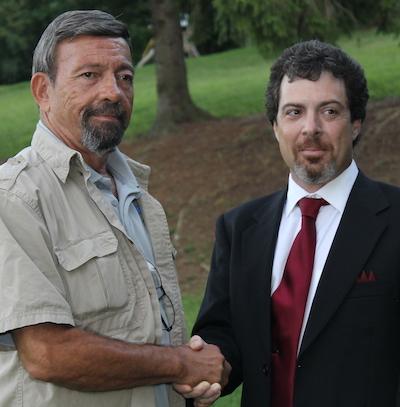
Marty Hayes: We’re here today with Mr. Chris Ferro, an attorney from York, PA and Mr. Spencer Newcomer. I have titled today’s discussion The Anatomy of a Self-Defense Shooting. I was privileged to work as an expert witness with both of these gentlemen.
I was so taken with both Mr. Ferro’s professionalism and Mr. Newcomer’s innocence, that I felt that if we could discuss some of the things that happened in trial, it would be very beneficial for not only members of the Armed Citizens’ Legal Defense Network, but also for our Network affiliated attorneys, who may not have handled a case like this. There are a lot of good learning points here that I have wanted to discuss for a long time.
So, let’s start out with just a couple of easy questions. Spencer, can you just tell us a few things about yourself? How did you become an armed citizen?
Spencer Newcomer: My father taught me how to use firearms. From a young age, I would go hunting with him. I was on a small-bore shooting team. I’ve always loved the outdoors and my interest in firearms kind of fit in with that.
Hayes: Were you a gun collector?
Newcomer: Yes, I had a nice gun collection. Some I had inherited from my father. When his hunting buddy passed away, I purchased his collection from his widow. I’ve collected a few guns myself over the years.
Hayes: Can you give us a little bit of background about your training, shooting and reading about firearms?
Newcomer: In the past, I have subscribed to several firearms magazines. I followed closely Massad Ayoob’s writings, Jeff Cooper’s writings, and some of the other columnists. I had never actually had formal training, because I had learned from an early age how to use firearms and was proficient with them.
Hayes: Didn’t some of Ayoob’s writings come into play later in how you handled this incident?
Newcomer: Yes, absolutely, Massad’s information actually saved my life. It was a definite help.
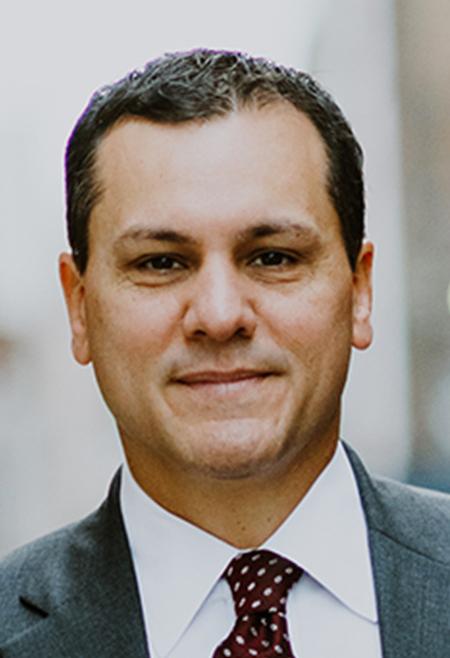 Hayes: Chris, could you tell us a little bit about your career as an attorney, where you went to law school, how long you’ve been practicing, that sort of thing?
Hayes: Chris, could you tell us a little bit about your career as an attorney, where you went to law school, how long you’ve been practicing, that sort of thing?
Chris Ferro: Sure. I graduated from Duquesne University School of Law in Pittsburgh in the late ’90s. After I graduated from law school, I returned to York, which is my hometown, and I took a job with the York County District Attorney’s Office.
I was an assistant district attorney for almost four years and during that time, I tried a lot of interesting, big cases. I did a stint as a child abuse prosecutor, a stint as a major crimes prosecutor, and so through that, I was able to prosecute and try a lot of homicide cases and other serious felony charges.
After about four years in the district attorney’s office, I realized it was time to move on to private practice. I took a position with a medium-sized, local law firm, and immediately began practicing primarily in the area of criminal defense. I was with that firm for almost nine years as a partner, and then I felt my practice was strong enough that I could start my own law firm, so several years ago that’s what I did–I went out on my own. My practice is almost exclusively criminal defense work, both in the state and federal courts.
During the course of my 15-year career, I’ve tried upwards of 100 jury trials. I’ve defended everything from DUI to murder and everything in between. I think I have, at this point, a pretty robust and varied criminal defense practice. It’s a general criminal practice, with no specific focus. Quite frankly, I think that’s a benefit, because the focus should be on the trial work. The focus should be on the preparation, and not necessarily any specific area of the law.
Hayes: Do you have much of a history with firearms use or did you have to get up to speed for this case?
Ferro: A little bit. I’ve always enjoyed the outdoors and I’ve always enjoyed hunting. But my primary experience with firearms has always been long guns–rifles or shotguns. I was never a handgun owner. I don’t have a license to carry. That was just not really a part of my life. There was an aspect of handguns, handgun ownership and license to carry that I really had to come to understand because I didn’t live it on a daily basis. By the way, I think that was incredibly helpful. Not being a person who carries a firearm daily, I was able to share the perspective from which most of our jurors came. I did not assume that every juror would understand why Spencer had a gun with him when he left the house that morning.
We had to take pains to make sure that we explained that to a jury. Quite frankly, I needed to figure that out, too. If I run down to the local convenience store to get milk for the kids, part of my life is not grabbing a firearm first. I came to understand that was a custom that Spencer had developed; obviously it wasn’t anything nefarious. He wasn’t looking to go out and cause havoc. It was just part of his life. Having understood and learned that from Spencer, I was able to educate the jury. If I had just assumed that carrying a gun was a natural, normal thing, I think I would have missed that opportunity to make that a teaching moment.
Hayes: That’s a very valid point. Spencer, let’s explain what preceded the shooting, specifically what were a few of the problems that you’d had with this neighbor?
Newcomer: A different neighbor was inciting the gentleman with whom I had the incident, claiming that my dogs defecated in his yard, which wasn’t true. He did not realize I had an electric fence and the dogs couldn’t get out. His claims were ratcheting up the bullying.
The neighbors would come over and vandalize my property, and when they weren’t getting a specific reaction from me, they changed tactics and they escalated the harassment. My only reaction was to call the police.
I’m a quiet person. I don’t socialize a great deal with my neighbors. I’m civil: I wave and say hi, but I didn’t really know them.
Hayes: Am I correct, then, to say that there was a long history of police reports about the neighbors’ harassment against you?
Newcomer: Yes. I’d made numerous reports. Actually, I had called the police and they were out three days before the incident.
Hayes: Chris, did this history play into the trial at all?
Ferro: Yes, the dynamic between Spencer and all of his neighbors was significant for a couple of reasons. Number one, Spencer’s state of mind at the time of the shooting was critical. We had a history showing Spencer had reached out through normal means to the police, meaning he wasn’t a vigilante. He didn’t take things into his own hands. When he believed someone was harming him, trespassing, bullying him, he took the rational step. He called police and asked for their intervention. He asked for their help. Now, the police were really of no assistance; that’s not really a function of the police, because how could the police ever prove who did the vandalism and who was behind the harassment?
I think that Spencer’s history of showing restraint and reporting the harassment and vandalism to police was significant when we needed to show what his state of mind was the day of the shooting. He is someone who was pushed and pushed and pushed to the point of concern and fear. Through all of these incidents, we were able to show that the deceased was pushing the limits. That history showed the deceased in an incredibly negative light. It showed Spencer as someone that was not out for blood, not quick to react. It showed he was a reasonable, rational person who was pushed into this situation.
Hayes: Spencer, why don’t you tell us what happened that day?
Newcomer: I left my house at approximately 9:00 a.m. I was on my way to a car show. I had to drive up to my mother’s house to make copies of fliers and I was really focused on the day’s events. It was a very important show for my car club and me. A group of us was going to drive down together. I had people waiting for me.
As I left the house, the other neighbor called out and wanted to talk to me, which was kind of unusual because of the prior history. It was like he was trying to hold me up. I was in a hurry, so I said politely, “Hello, how are you? I really have to be going.” I got in my truck and backed out of the driveway.
As I start to pull down the street, I saw the deceased charging down his driveway to the street, so that he was basically waiting for me. When I got there, I stopped. The night before, he had been screaming at my girlfriend, making threats, so I stopped. It was obvious he wanted to say something. I stopped my truck and he started screaming.
I wanted to tell him that this shouldn’t be going on. I said, “Just leave us alone.” I started to pull away, and he said, “I’m going over to kill your dogs.” It took a moment as I was going down the street for that to sink in. I thought, “Crap, I have to stop. I can’t leave now.” I pulled over. I look back over my right shoulder and I did not see him. I assumed he was still standing by his mailbox.
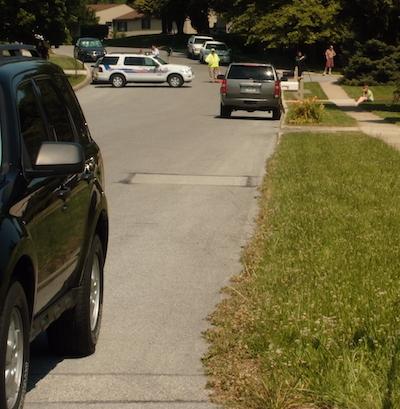
[See photo, right: Residents park on both sides of the street that Newcomer lived on, so when he stopped, his truck was somewhat in the middle of the street.]
Newcomer: Yes, I’d been driving down the middle of the street. It’s a residential area with very little traffic and the way the cars are parked on the side of the street, you drive down the center of the street. So, I got out of the lane of traffic. I opened my door and got out to tell him, “Stop or I’m calling the cops. You’re not going to go over and kill my dogs,” not realizing as I got out that he had closed a distance of about 140 feet. To my shock, when I got out, he was at the back of my truck. It’s a small pickup truck, a GMC Sonoma. It has a six-foot bed, so he was close. That’s when he said, “I’m going to fix you. I’m going to kill you.”
Hayes: Did you have your gun on you?
Newcomer: No, the gun was on the seat in the truck. As I have always done, I had taken it in and out of the house–nothing special about it that morning. When I looked at him, I knew I was in trouble. I’m not a very big guy, I have no hand-to-hand training of any kind. The way he was coming at me and with his size, his rage, his training, I knew if he got ahold of me, I was dead.
Hayes: You’re 5’ 4’’? How much did you weigh?
Newcomer: Yes. At the time, I weighed 150 pounds.
Hayes: OK, and the deceased was about 5’ 7’’, but he was very stocky, very muscular, if I recall.
Newcomer: Yes, he went to the gym and worked out with a private trainer.
Hayes: He weighed about 180, I think, so he out-weighed you considerably. Obviously, he was much stronger, and a former Marine, so his military background, training and skill was part of your understanding of this fellow’s mindset. He was aggressive.
Newcomer: Correct. I knew he was a former Marine. I knew the Marines are taught combat. I knew he had seen combat before he had been retired.
Hayes: OK, so then what happened?
Newcomer: I knew I was in trouble from the rage in his eyes and the way he growled at me. I reached into the car. I pulled out the pistol and pointed it at him, which stopped him. He had closed the distance from the end of the truck at that point and he was two or three feet away from me.
I said, “Get back.” He did not. His body position was–I guess the easiest way for people to understand is he was standing like a boxer, turned to the side, leaning forward to attack.
Hayes: His body positioning at that moment is what we in the business call a pre-attack indicator, showing that he was getting ready to attack.
Newcomer: I did not know the name of it at the time, but I think through body language, you can naturally tell when someone’s being obviously aggressive. That is what he was displaying.
I was becoming more and more focused because of this intense situation. The tackypsychia had the edges of my vision focused down until the firearm was not in my field of view. I was looking into his eyes, and his reaction was not what I would have expected. You would normally expect someone to back up and want to get away from the situation. That was not his demeanor.
He looked even more infuriated. Looking into his eyes, I could tell something was going through his mind. That’s when I looked down and saw his hand coming out of his pocket. I saw his hand held a black object and it looked to me just like a Glock, a polymer-type pistol.
Hayes: Right side, left side, do you remember?
Newcomer: Right side.
Hayes: I knew you remembered because left hand or right hand was a pivotal part of the trial, which we’ll get to later, but I want readers to remember this point. He was aggressive. His stance was bladed and he had just threatened to kill you. He wasn’t acting like a normal person would when you displayed the gun and told him to stop. Instead, he reached into a pocket and grabbed a black object.
Newcomer: Correct.
Hayes: You then shot him, right?
Newcomer: Yes.
Hayes: What did you see and feel during that one to two seconds?
Newcomer: I felt pure terror: absolute, pure terror. Everything happened incredibly fast. Obviously, I had never experienced anything like that before. I fired. I did not have any idea of how many times I fired. He spun away from me and fell and I stopped firing.
Hayes: The evidence showed he was shot once in the back. Do you recall actually shooting him in the back?
Newcomer: No. I did not know that until after the autopsy. Chris informed me of it later.
Hayes: We’ll be talking about the shot in the back later. How did the next few minutes play out?
Newcomer: Well, I put the gun on the seat. immediately I called 911 and briefly explained the situation, then I disconnected. People started coming out. He was right alongside of my truck, so I told everybody, “I’m not
leaving, but I’m going to move my truck so the ambulance can get in here.” I moved my truck across the street, which may not have been a good thing. In retrospect, it probably would have been better if it had stayed put; it would have made a clearer picture of what happened.
I saw the police coming down the street. I was sitting on the curb, away from the deceased and the crowd that was gathering. I stood up and took a step or two into the middle of the street with my hands in the air. I was not armed. I had put my firearm away in the truck.
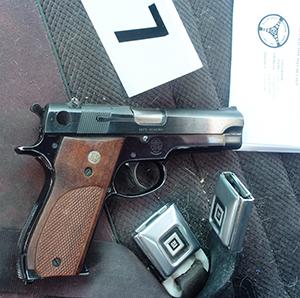 Hayes: In fact, there’s a picture of the gun on the seat. It was a Smith and Wesson, Model 39-2 with a manual decocker.
Hayes: In fact, there’s a picture of the gun on the seat. It was a Smith and Wesson, Model 39-2 with a manual decocker.
Newcomer: Correct.
Hayes: When I looked at that, I said, “Man, that gun is no longer cocked!” Do you remember decocking the gun?
Newcomer: No, that was just a habit from training. That’s what I had learned, so that action is automatic.
Hayes: So, you met the police with your hands raised. What happened next?
Newcomer: The officer told me to turn around and get down. I turned around and started to get down and he jumped on me, put me in handcuffs and dragged me to the squad car.
Hayes: Did he ask you what was going on?
Newcomer: He only asked me if I was the shooter, and I said yes, then he put me in a squad car. I don’t know, but I think I was in there for 10 or 15 minutes. It seemed like an eternity. The adrenaline and everything started coming out of my system and I just started sobbing uncontrollably. My whole body felt like I was being hit by waves of cold water. My mouth was dry and then it was not. I started dry heaving. It felt like an elephant was sitting on my chest. I thought I was actually having a heart attack. That’s when they came and got me out of the squad car. It was a hot day and the windows were up. I was sweating profusely from the heat and from the stress. They took me over to the ambulance. I was almost unconscious.
The officer asked me a couple of questions. I told him, “He was coming at me. He reached into his pocket to pull out a gun and I fired.” He said, “Well, why didn’t you just drive away?”
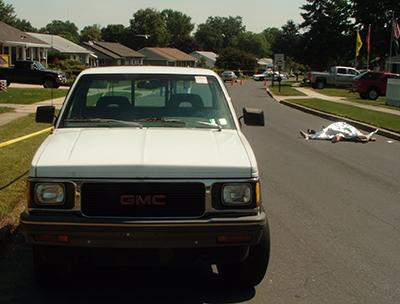 I looked up and I saw my truck was on the other side of the street, and it was just too much. I don’t think I could have really formed any sort of narrative at that point because of my emotional state. Even talking was a chore at that moment.
I looked up and I saw my truck was on the other side of the street, and it was just too much. I don’t think I could have really formed any sort of narrative at that point because of my emotional state. Even talking was a chore at that moment.
[Note: Crime scene photo shows position to which Newcomer had moved his truck to allow ambulance access to Wintermyer.]
I remembered what Massad had taught: that’s not the time to try and give your narrative. I told them that I would be more than happy to give them a statement once my attorney was present.
Hayes: OK, and so they took you to the hospital, got you checked out and then they took you down to the police station to talk?
Newcomer: Correct, they took me to the hospital then to the police station, but they never talked to me after that.
Hayes: You had invoked your right to counsel.
Newcomer: Yes, I told the police a second time at the hospital that I would be more than willing to talk to them with an attorney present. I signed a card stating that they’d read me my Miranda rights and that was the end of that.
Hayes: Chris, please give us your recollection of how you first heard about the case and who contacted you? How did you get involved?
Ferro: Well, the location where this took place is actually not too far from my home. It’s not often in one of these neighborhoods that you have a shooting that results in a death. There’s an elementary school within 1,000 yards from where this took place. It’s very quiet, with tree lined streets. It’s the last place in the world you would expect a homicide. It was big news from the very beginning. Spencer’s family reached out to me, probably late the day this incident took place or early the next day. We had some initial discussions and I had to tell them that there was not a whole lot that can be done that very second.
My first step was to talk to Spencer, to understand what took place that day. He was charged with homicide, including murder in the first degree. In Pennsylvania, that’s a non-bailable offense, so we were not getting him out of jail. Based on what he was charged with, I knew this was going to be a long, difficult process and I needed Spencer and his family to understand that.
From the beginning you know that it’s going to be financially difficult for any one person to bring this case to a successful conclusion. Most people do not save money thinking, “Someday I’m going to be charged with criminal homicide and have to hire an attorney and investigators and experts to win my freedom back.” Spencer was no different. Luckily, he had a number of family members who cared deeply about him and had at least some financial resources.
I had to tell them, “It’s going to be expensive. It’s going to take a long time. Not only are you going to be paying for my fees, but I anticipate, that we’re going to need to hire experts in different fields. They are not going to be cheap, but they are going to be incredibly necessary.” Most people don’t have family members who step up and pay the initial retainer. Any attorney considering taking a case like this has to have a financial commitment from the family. It’s expensive.
Hayes: Are you comfortable talking about the exact finances of Spencer’s case and discuss the amount of money required?
Ferro: I can discuss it in broad strokes. There are two ways that any criminal defense attorney can charge: a flat fee or an hourly rate. In more complicated criminal matters, I will generally charge my hourly rate because I have no idea the twists and turns that the case will take from beginning to end. I have no idea about how many hours it is going to involve. We had a discussion and Spencer’s family agreed to pay my hourly rate.
I initially requested a $10,000 retainer in order to move quickly on what needed to be accomplished. I was comfortable with Spencer and his family and I knew that as I needed additional funds, I could ask. As it turned out, that happened multiple times. Ultimately, after going to trial, there was still a balance that was due and owing, based largely on the number of hours that went into the preparation of this case and then the actual trial.
The cost was significant. For a member or an attorney considering one of these cases, when it’s all said and done, you’re looking at fees in the $60,000 to $100,000 range, depending upon a bunch of different factors. But that’s the general range.
Hayes: That’s pretty much what I’ve heard from several attorneys: $50,000 to $100,000, plus experts and other people you may need. In fact, you’re still owed money for your work on this case, right? Spencer hasn’t been able come up with the total payment yet, but that’s the nature of the business you’re in.
Ferro: That’s correct. We’re hoping some of your members may be moved by Spencer’s story and will help him out. That would certainly be wonderful.
Editor’s note: Considering how much material this interview needs to cover, we will break it into several installments. This is a good place to pause the story for now. We return next month with details from criminal defense attorney Christopher Ferro about the challenges he faced in preparing the case to go to trial. We hope you will return to these pages next month when Hayes, Ferro and Newcomer report about explaining armed self defense at the trial and the outcome.
To read more of this month's journal, please click here.
